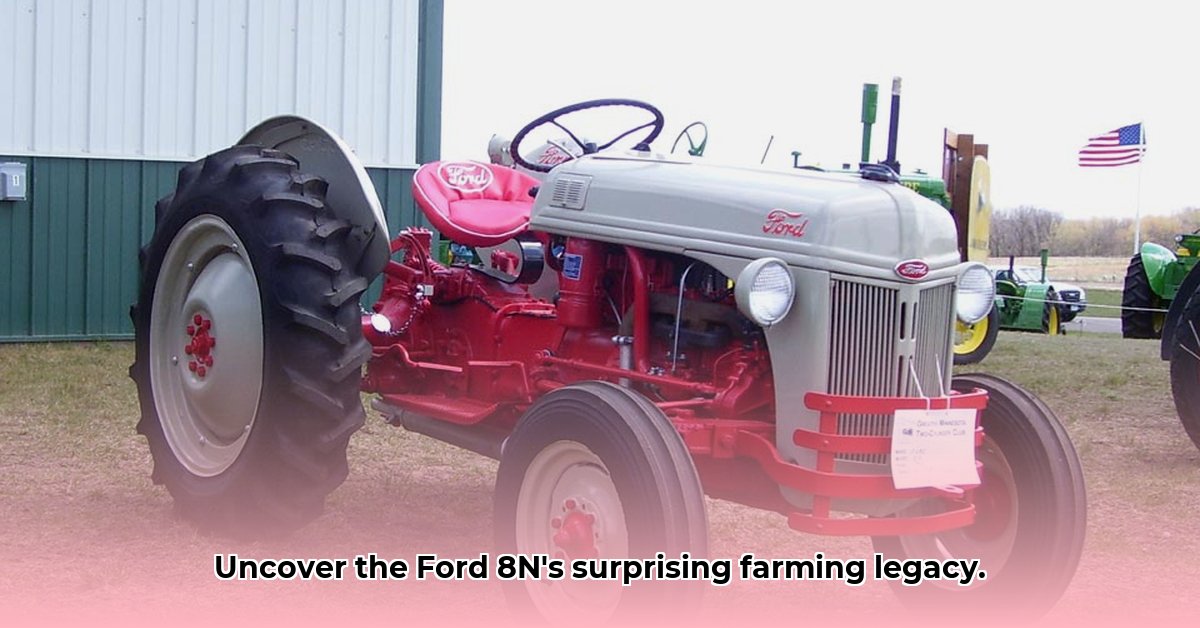
The Ford 8N tractor, with its approximately 27 horsepower (hp), may seem underpowered compared to modern agricultural machinery. However, this seemingly modest workhorse played a pivotal role in post-World War II agricultural transformation. Its impact extended far beyond its horsepower rating, influencing farming practices and raising questions about sustainable agriculture that remain relevant today. For more on Ford tractors, see this site.
The 8N's Efficiency and Affordability: A Mechanization Revolution
The Ford 8N's success wasn't solely due to its horsepower; its efficiency and affordability were equally crucial. While precise fuel consumption data is scarce, its lower horsepower likely resulted in reduced fuel usage compared to larger tractors. This was a significant advantage for financially-constrained farmers during the post-war period. This affordability, coupled with its relatively simple design, democratized mechanized farming, bringing efficiency gains to a broader range of farmers. But was this efficiency truly sustainable? The answer, as we will see, is complex.
How did the 8N's relatively low horsepower contribute to its overall efficiency compared to its larger, more powerful contemporaries? Was this efficiency truly sustainable given its impact on the environment?
Environmental Considerations: A Historical Perspective
While the 8N undeniably boosted productivity, its environmental impact requires careful consideration. Lacking modern emission controls, it generated higher greenhouse gas emissions than today's tractors. Furthermore, its weight contributed to soil compaction, negatively affecting water absorption and long-term soil health. This highlights a critical tension: increased agricultural efficiency versus potential environmental damage. "The Ford 8N represents a crucial turning point," explains Dr. Emily Carter, Agricultural Historian at the University of California, Berkeley, "It showcased the potential of mechanization, but also highlighted the early challenges of balancing productivity with environmental responsibility."
What quantifiable data exists to support claims regarding the 8N's fuel consumption and greenhouse gas emissions compared to modern standards? What methods can be employed to accurately assess the long-term environmental impact of the 8N?
The Ford 8N and Sustainable Agriculture: A Complex Legacy
Despite its limitations, the Ford 8N served as a bridge to mechanized farming. Its lower horsepower, coupled with reliability and simpler mechanics, suggests potential advantages for smaller-scale, sustainable farming operations today. Its lower power requirements could translate to less intensive farming practices, reducing dependence on fossil fuels and minimizing soil disturbance. This legacy, however, is not without its complexities.
How can the Ford 8N's design and operational characteristics inform the development of improved sustainable agricultural technologies? What are the key challenges in adapting this historical technology to modern contexts?
Comparing the 8N to Modern Tractors: A Technological Leap
Modern tractors boast horsepower figures far exceeding the 8N's 27 hp, often reaching well over 100 hp. This power increase, however, comes at a cost. Larger, more powerful tractors generally consume significantly more fuel and have a larger environmental footprint. This prompts critical reflection: Can we learn from the past to create a more environmentally friendly agricultural future? The Ford 8N's legacy serves as a compelling case study to explore this complex question.
What are the key differences in fuel efficiency, emissions, and soil compaction between the Ford 8N and modern tractors? Can an apples-to-apples comparison be made to account for the differences in scale and operational context?
Ongoing Research and Future Directions
Further research is needed to fully understand the Ford 8N's long-term environmental impact. Detailed studies on fuel consumption, emissions, and soil compaction across its operational lifespan are crucial to refine our understanding of the long-term effects of mechanization in farming. This research will enable a more nuanced evaluation of the 8N's contribution to – or detriment of – sustainable agriculture.
What specific research methodologies can be used to obtain accurate data relating to the Ford 8N's fuel consumption, emissions, and soil compaction? How can this data be effectively contextualized within contemporary sustainable agriculture frameworks?
Unexpected Applications: The 8N's Continuing Relevance
Even today, the Ford 8N may find utility in specific sustainable farming applications. Its lower power and simpler mechanics make it suitable for smaller farms or tasks requiring less intensive mechanization. Its potential use in heritage farming or specialized agriculture, where fuel efficiency and minimized soil disturbance are priorities, warrants further exploration.
What are the potential sustainable farming applications of the Ford 8N in contemporary agriculture? How can its design characteristics inspire future developments in sustainable agricultural machinery?
Conclusion: A Balanced Perspective on the 8N's Enduring Impact
The Ford 8N's legacy is multifaceted. Whilst significantly advancing agricultural efficiency, it also highlighted the early challenges of balancing productivity and environmental sustainability. Its story serves as a constant reminder of the need for continuous improvement in farming methods to achieve true sustainability. It's a testament to agricultural progress but also a call for careful consideration of the trade-offs involved in technological advancement.
What lessons can be learned from the Ford 8N’s legacy to inform the ongoing development of sustainable agricultural technologies? How can the challenges and successes of this historical tractor be used to address contemporary issues in sustainable agriculture?